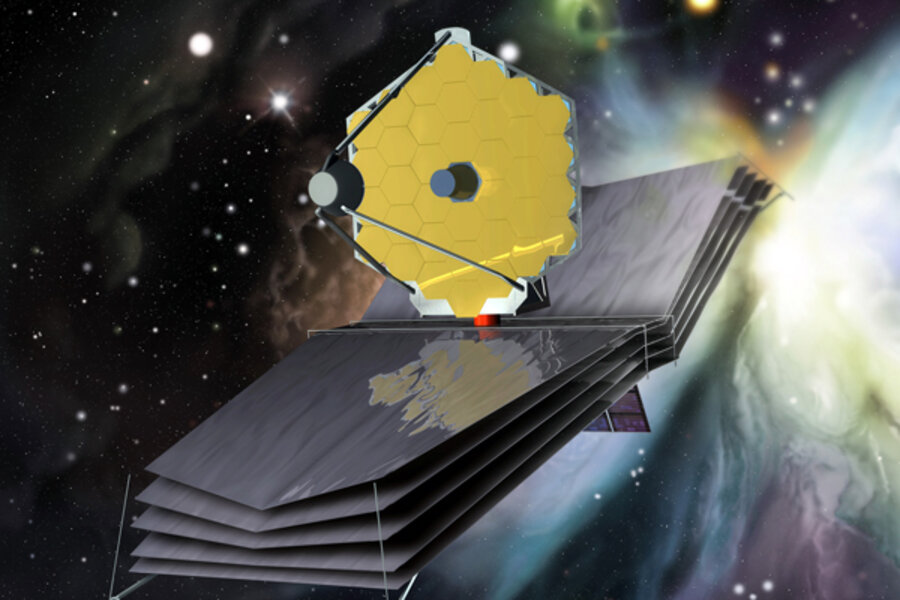NASA's next big space telescope in financial trouble
Loading...
NASA's James Webb Space Telescope (JWST), the long-anticipated successor to the Hubble Space Telescope, is in serious financial trouble, according to a project review panel.
The culprits: bad management and flawed budgets from managers, the panel concludes – not hardware challenges or a tightfisted Congress.
Overall, the telescope's cradle-to-grave budget, currently pegged at $5 billion, will need another $1.5 billion to live up to its scientific promise, the review panel estimated in a report released late Wednesday afternoon.
"The bottom line is that there was just not enough money in the budget to execute the work that was required," said John Casani, head of the review panel, in a press briefing. Mr. Casani is special assistant to the director of the National Aeronautics and Space Administration's Jet Propulsion Laboratory in Pasadena, Calif.
The project, initially called the Next Generation Space Telescope, has been a top priority for astronomers and astrophysicists for at least two decades. Given the prospect of a tool roughly 1,000 times more powerful than Hubble, it's little wonder that many an astronomy-research paper ends with a sentence or two anticipating the improved results that the JWST will deliver.
If the telescope is to be launched in 2015, as currently envisioned, the project will need an additional $250 million beyond the level Congress already has authorized for the project in fiscal year 2011, according to the panel. It will also need another $250 million above its projected budget for 2012.
Deferring a 2015 launch and stretching out the project to ease budget demands in any one year would only boost the telescope's long-term costs, which include operations for up to 10 years once it's in orbit.
The panel indicated it could find no obvious places to cut costs, but it recommended several changes to the way the program is run that would reduce the likelihood of additional cost overruns.
Finding the extra money that the review panel says is needed to complete the complex telescope in time for a 2015 launch will be a challenge, NASA officials acknowledge. Between President Obama's emphasis on deficit reduction and the GOP's new majority in the House, which will be inclined to spend less, the prospects for additional dollars for the telescope appear dim.
NASA will be working with the president and Congress to see what can be done, says Christopher Scolese, NASA's associate administrator. But, he adds, "I think it's fair to say we're not going to find $200 million."
In responding to the review's release, NASA officials also announced an overhaul of the project's organizational structure. NASA Administrator Charles Bolden said in a statement released Wednesday that he has pulled leadership duties from the Goddard Space Flight Center in Greenbelt, Md., into NASA headquarters in Washington. He appointed Richard Howard, the agency's deputy chief technologist, to oversee the project.
“I am encouraged the [review panel] verified our assessment that JWST is technically sound, and that the project continues to make progress and meet its milestones. However, I am disappointed we have not maintained the level of cost control we strive to achieve – something the American taxpayer deserves in all of our projects," Mr. Bolden said.
NASA once again is thus grappling with issues that have bedeviled it since the end of Apollo. From the shuttle to the Constellation Program, budgets for many flagship projects have ballooned far beyond overruns typical for never-done-this-before aerospace projects – either because the agency was overly optimistic about what it would take to do the job or because Congress didn't fully fund an otherwise carefully budgeted program – or both.
The telescope itself has been a technological challenge. Instead of a single light-gathering mirror, as the Hubble Space Telescope has, the JWST's mirror is made up of segments that must be carefully controlled on orbit to maintain the right shape. That segmented mirror is about 21 feet wide, compared with Hubble's eight-foot-wide mirror. The wider mirror allows the JWST to see faint objects that Hubble can't spot.
It is designed to orbit the sun in a region of space some 932,000 miles from Earth called the L2 point – a gravitational sweet spot beyond the night half of Earth where the Earth's and sun's gravity virtually cancels each other. The telescope can then remain in its location without having to carry large quantities of fuel for orbital corrections.
The telescope is designed to collect and analyze objects at infrared wavelengths, rather than with visible or ultraviolet light. This will allow it to spot the universe's first galaxies some 13.5 billion light-years away, as well as budding solar systems and planets in the Milky Way, designers say.





